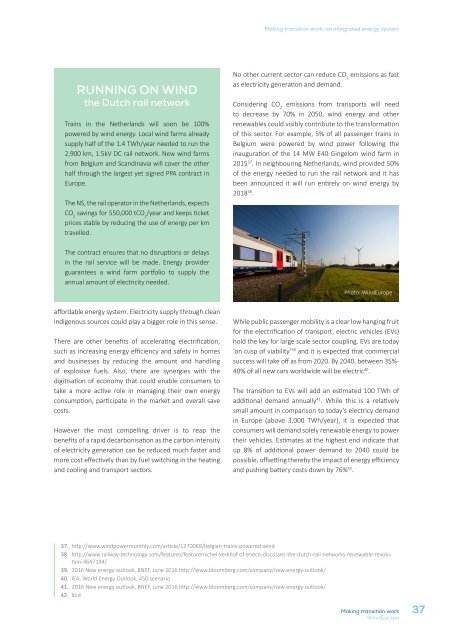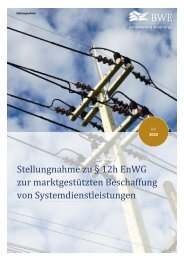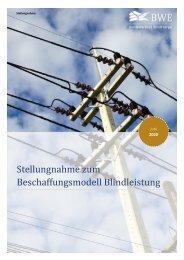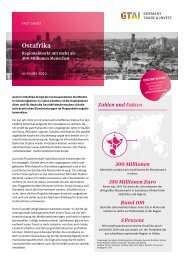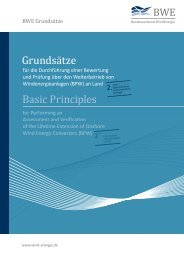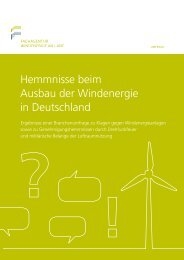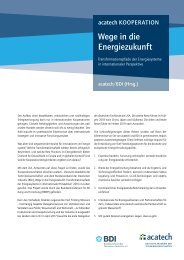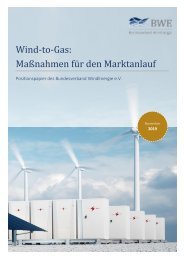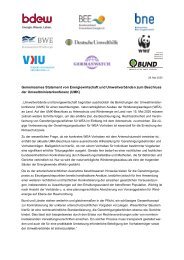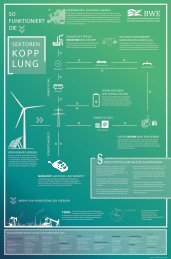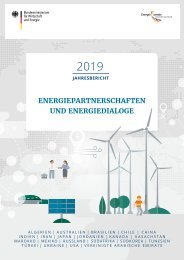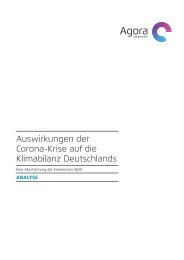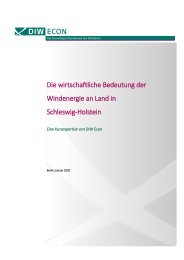Making transition work - Wind Europe
This report provides clear elements on how to make transition work in the coming decade. It provides recommendations to policymakers on how to facilitate a swift transformation of the energy system and considers the policies that will make Europe the best choice for those investing in renewables.
This report provides clear elements on how to make transition work in the coming decade. It provides recommendations to policymakers on how to facilitate a swift transformation of the energy system and considers the policies that will make Europe the best choice for those investing in renewables.
You also want an ePaper? Increase the reach of your titles
YUMPU automatically turns print PDFs into web optimized ePapers that Google loves.
<strong>Making</strong> <strong>transition</strong> <strong>work</strong>: an integrated energy system<br />
RUNNING ON WIND<br />
the Dutch rail net<strong>work</strong><br />
Trains in the Netherlands will soon be 100%<br />
powered by wind energy. Local wind farms already<br />
supply half of the 1.4 TWh/year needed to run the<br />
2,900 km, 1.5kV DC rail net<strong>work</strong>. New wind farms<br />
from Belgium and Scandinavia will cover the other<br />
half through the largest yet signed PPA contract in<br />
<strong>Europe</strong>.<br />
The NS, the rail operator in the Netherlands, expects<br />
CO 2<br />
savings for 550,000 tCO 2<br />
/year and keeps ticket<br />
prices stable by reducing the use of energy per km<br />
travelled.<br />
The contract ensures that no disruptions or delays<br />
in the rail service will be made. Energy provider<br />
guarantees a wind farm portfolio to supply the<br />
annual amount of electricity needed.<br />
affordable energy system. Electricity supply through clean<br />
indigenous sources could play a bigger role in this sense.<br />
There are other benefits of accelerating electrification,<br />
such as increasing energy efficiency and safety in homes<br />
and businesses by reducing the amount and handling<br />
of explosive fuels. Also, there are synergies with the<br />
digitisation of economy that could enable consumers to<br />
take a more active role in managing their own energy<br />
consumption, participate in the market and overall save<br />
costs.<br />
However the most compelling driver is to reap the<br />
benefits of a rapid decarbonisation as the carbon intensity<br />
of electricity generation can be reduced much faster and<br />
more cost effectively than by fuel switching in the heating<br />
and cooling and transport sectors.<br />
No other current sector can reduce CO 2<br />
emissions as fast<br />
as electricity generation and demand.<br />
Considering CO 2<br />
emissions from transports will need<br />
to decrease by 70% in 2050, wind energy and other<br />
renewables could visibly contribute to the transformation<br />
of this sector. For example, 5% of all passenger trains in<br />
Belgium were powered by wind power following the<br />
inauguration of the 14 MW E40 Gingelom wind farm in<br />
2015 37 . In neighbouring Netherlands, wind provided 50%<br />
of the energy needed to run the rail net<strong>work</strong> and it has<br />
been announced it will run entirely on wind energy by<br />
2018 38 .<br />
Photo: <strong>Wind</strong><strong>Europe</strong><br />
While public passenger mobility is a clear low hanging fruit<br />
for the electrification of transport, electric vehicles (EVs)<br />
hold the key for large scale sector coupling. EVs are today<br />
‘on cusp of viability’ 39 and it is expected that commercial<br />
success will take off as from 2020. By 2040, between 35%-<br />
40% of all new cars worldwide will be electric 40 .<br />
The <strong>transition</strong> to EVs will add an estimated 100 TWh of<br />
additional demand annually 41 . While this is a relatively<br />
small amount in comparison to today’s electricy demand<br />
in <strong>Europe</strong> (above 3,000 TWh/year), it is expected that<br />
consumers will demand solely renewable energy to power<br />
their vehicles. Estimates at the highest end indicate that<br />
up 8% of additional power demand to 2040 could be<br />
possible, offsetting thereby the impact of energy efficiency<br />
and pushing battery costs down by 76% 42 .<br />
37. http://www.windpowermonthly.com/article/1370069/belgian-trains-powered-wind<br />
38. http://www.railway-technology.com/features/featuremichel-kerkhof-of-eneco-discusses-the-dutch-rail-net<strong>work</strong>s-renewable-revolution-4647194/<br />
39. 2016 New energy outlook, BNEF, June 2016 http://www.bloomberg.com/company/new-energy-outlook/<br />
40. IEA, World Energy Outlook, 450 scenario<br />
41. 2016 New energy outlook, BNEF, June 2016 http://www.bloomberg.com/company/new-energy-outlook/<br />
42. Ibid<br />
<strong>Making</strong> <strong>transition</strong> <strong>work</strong><br />
<strong>Wind</strong><strong>Europe</strong><br />
37


